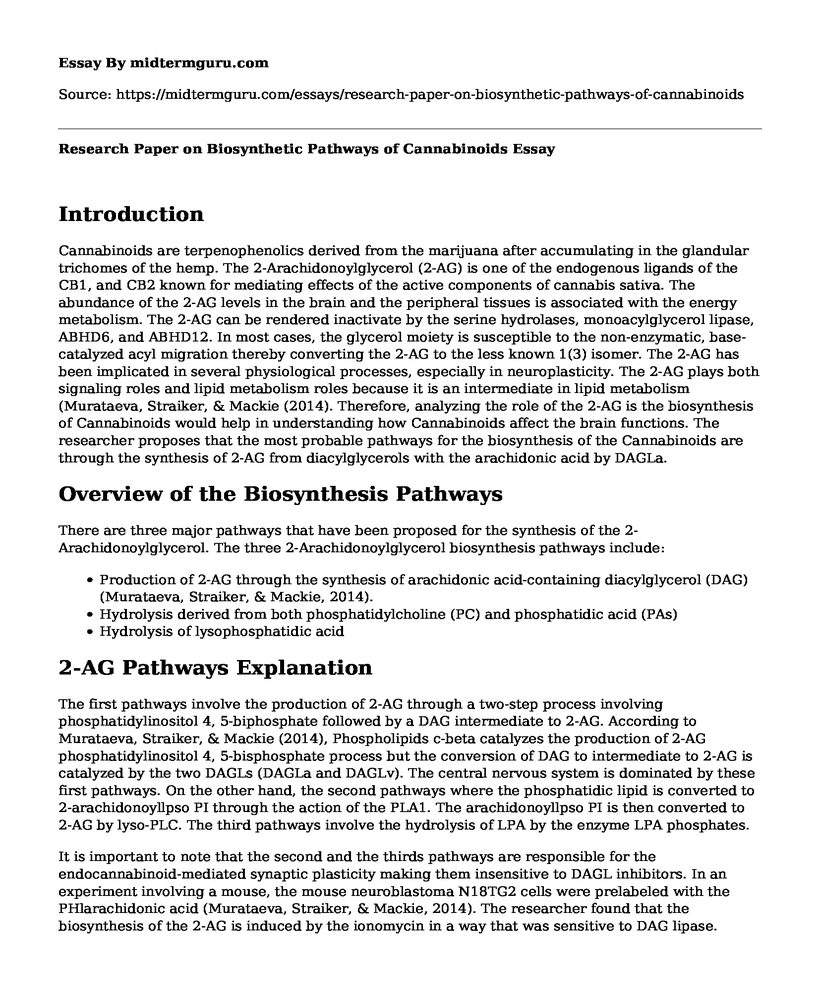Introduction
Cannabinoids are terpenophenolics derived from the marijuana after accumulating in the glandular trichomes of the hemp. The 2-Arachidonoylglycerol (2-AG) is one of the endogenous ligands of the CB1, and CB2 known for mediating effects of the active components of cannabis sativa. The abundance of the 2-AG levels in the brain and the peripheral tissues is associated with the energy metabolism. The 2-AG can be rendered inactivate by the serine hydrolases, monoacylglycerol lipase, ABHD6, and ABHD12. In most cases, the glycerol moiety is susceptible to the non-enzymatic, base-catalyzed acyl migration thereby converting the 2-AG to the less known 1(3) isomer. The 2-AG has been implicated in several physiological processes, especially in neuroplasticity. The 2-AG plays both signaling roles and lipid metabolism roles because it is an intermediate in lipid metabolism (Murataeva, Straiker, & Mackie (2014). Therefore, analyzing the role of the 2-AG is the biosynthesis of Cannabinoids would help in understanding how Cannabinoids affect the brain functions. The researcher proposes that the most probable pathways for the biosynthesis of the Cannabinoids are through the synthesis of 2-AG from diacylglycerols with the arachidonic acid by DAGLa.
Overview of the Biosynthesis Pathways
There are three major pathways that have been proposed for the synthesis of the 2-Arachidonoylglycerol. The three 2-Arachidonoylglycerol biosynthesis pathways include:
- Production of 2-AG through the synthesis of arachidonic acid-containing diacylglycerol (DAG) (Murataeva, Straiker, & Mackie, 2014).
- Hydrolysis derived from both phosphatidylcholine (PC) and phosphatidic acid (PAs)
- Hydrolysis of lysophosphatidic acid
2-AG Pathways Explanation
The first pathways involve the production of 2-AG through a two-step process involving phosphatidylinositol 4, 5-biphosphate followed by a DAG intermediate to 2-AG. According to Murataeva, Straiker, & Mackie (2014), Phospholipids c-beta catalyzes the production of 2-AG phosphatidylinositol 4, 5-bisphosphate process but the conversion of DAG to intermediate to 2-AG is catalyzed by the two DAGLs (DAGLa and DAGLv). The central nervous system is dominated by these first pathways. On the other hand, the second pathways where the phosphatidic lipid is converted to 2-arachidonoyllpso PI through the action of the PLA1. The arachidonoyllpso PI is then converted to 2-AG by lyso-PLC. The third pathways involve the hydrolysis of LPA by the enzyme LPA phosphates.
It is important to note that the second and the thirds pathways are responsible for the endocannabinoid-mediated synaptic plasticity making them insensitive to DAGL inhibitors. In an experiment involving a mouse, the mouse neuroblastoma N18TG2 cells were prelabeled with the PHlarachidonic acid (Murataeva, Straiker, & Mackie, 2014). The researcher found that the biosynthesis of the 2-AG is induced by the ionomycin in a way that was sensitive to DAG lipase. When PAS is remodeled using LPA and AA, to secretory phospholipase A2 (PLA2), the AA is concentrated in sn-2 of the phosphatidic acid (PA). DAGLa mRNA is highly expressed throughout the human brain especially in the hippocampus, striatum, ventral tegmental area and cerebellum while the expression pattern of the DAGLv is quite poor. The cannabis sativa is highly associated with the synaptic excitation. CB1 is predominant at the excitatory synapse while the DAGLa is usually in close proximity which means that the pre-synaptic whole the DAGLa is post-synaptic (Murataeva, Straiker, & Mackie, 2014). In the DAGLa knockout mice, the 80% reduction in the 2-AG levels in the brain and spinal cord explains the relationship between cannabinoids synthesis.
Conclusion
The stimulus-induced increase of the 2-AG in the brain are lost which mean that DAGLs is responsible for a larger percentage of 2-AG in the brain, spinal cord and peripheral tissues that are synapse-rich. This confirms the hypothesis of the role of DAGLa in the synthesis of the 2-AG. Never the less, it is important to research on the effect of the possible confounding factors such as the interaction or corporation between several enzymes.
Reference
Bisogno T, Melck D, De Petrocellis L, &, Di Marzo V. (1999). Phosphatidic acid as the biosynthetic precursor of the endocannabinoid 2-arachidonoylglycerol in intact mouseneuroblastoma cells stimulated with ionomycin. J Neurochem. 72(5), 2113-9.
Murataeva, N., Straiker, A., & Mackie, K. (2014). Parsing the players: 2-arachidonoylglycerol synthesis and degradation in the CNS. British journal of pharmacology, 171(6), 1379-91.
Cite this page
Research Paper on Biosynthetic Pathways of Cannabinoids. (2022, Sep 25). Retrieved from https://midtermguru.com/essays/research-paper-on-biosynthetic-pathways-of-cannabinoids
If you are the original author of this essay and no longer wish to have it published on the midtermguru.com website, please click below to request its removal:
- Overview of the EEG Signal Processing Technique
- Reflection of the Patient During Practicum Experience: Gastroesophageal Reflux Disease
- Memory, Learning, Creativity and Intelligence Interrelation - Essay Sample
- Law Enforcement Agencies Evolve to Combat Crime in Changing Society - Research Paper
- Reflective Essay on American Museum of Natural History
- Paper Example on Darwin's Theory of Evolution
- A Woman With A 24-Hours Memory - Essay Sample







